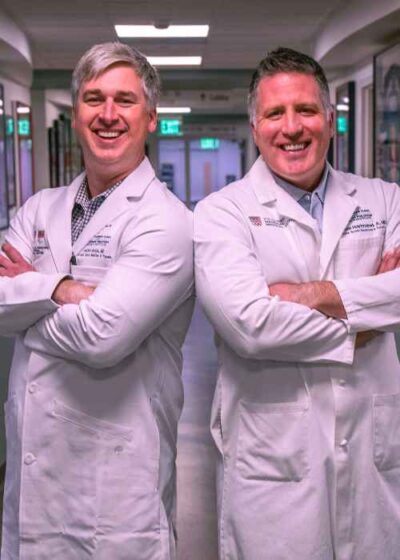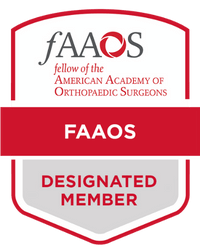Achilles Tendon Specialists
Have you experienced a recent ankle injury that resulted in pain or swelling above and around the ankle? If so, you may have experienced an injury to the Achilles tendon. Injuries to this tendon can occur in athletes and non-athletes who participate in activities involving frequent running or jumping. Ankle specialists, Doctors Thomas Haytmanek and Jonathon Backus provide diagnosis as well as treatment for patients in Vail and Frisco, Colorado, as well as Denver, Boulder, and surrounding Summit County areas who are experiencing ankle pain and swelling. Contact The Steadman Clinic’s Sports Foot and Ankle team today!

What is the Achilles Tendon?
The Achilles tendon is the largest tendon in the body and runs just behind the ankle. It is the tendon that connects the heel bone to the calf muscles, supporting the lower body when you walk, jump, or run. The Achilles tendon is vulnerable to injury in athletes of all sports. Tendonitis of the Achilles tendon usually occurs from an overuse phenomenon. The pain can occur in two primary locations: at the insertion of the tendon or a few centimeters above, and there is usually some associated swelling. It is a common, yet painful injury, that if not treated can sideline athletes and non-athletes for weeks to months.
What are Achilles Tendon Injury Symptoms?
The primary complaint from patients suffering from Achilles tendonitis is pain and swelling just above the posterior heel. Pain is maximum just above the area where the tendon attaches at the heel or directly at the attachment site. Pain is often the most intense after a period of sitting or long segments of inactivity while the tissue is not properly warmed up. Pain is also present during sporting activities or exercise where running and jumping are involved.
How is a torn Achilles Tendon diagnosed?
Our physicians will perform an extensive physical exam including x-rays of the heel. X-rays identify bone spurs or calcifications within the tendon. X-rays also allow identification of a bony prominence on the back of the heel that can irritate the Achilles tendon (e.g. a Haglund’s deformity) which can exacerbate Achilles tendon pain. An MRI is usually necessary to evaluate for partial tearing of the tendon, ganglion cysts within the tendon, or stress fractures of the calcaneus (heel bone).
Does an Achilles Tendon Injury Require Surgery?
Early treatment of Achilles tendonitis depends on whether it is insertional or non-insertional. Insertional tendonitis is an inflammatory condition and is treated with non-steroidal anti-inflammatory medication, eccentric stretching exercise, and silicone heel lifts.
Non-insertional Achilles tendonitis occurs in the “watershed” area of the Achilles where the blood supply is limited. The condition may or may not have a degree of inflammation associated with it but always involves some degree of degenerative damage to the tendon within the area of limited blood supply. Initial treatment involves stretching exercises and relative rest for the tendon along with use of a heel lift.
In patients who present with more severe symptoms, we may prescribe a boot, crutches, or complete immobilization of the ankle in a walking cast. Other minimally invasive treatment alternatives include the use of biologic injections into the tendon area, including platelet-rich plasma (PRP) or concentrated bone marrow aspirate (cBMA – stem cells). Steroids are not recommended since they can weaken the tendon and lead to a rupture.
What are the Surgical Treatment Options for an Achilles Tendon Injury?
In many cases, surgery will not be necessary in patients who have Achilles tendonitis. However, if conservative treatment fails to work after weeks to months, our physicians may suggest surgery. Surgery for Achilles tendonitis will depend on the location of the disease and the amount of damage to the tendon.
Achilles Tendon Surgical Procedures:
One alternative is a surgical lengthening of the calf muscle which is known as gastrocnemius recession. This involves cutting the fascia, or the covering over the muscle, which allows the muscle to stretch further. Patents who have a difficult time stretching or flexing their feet may benefit from this procedure. With this technique, the tightness in the Achilles tendon is usually relieved allowing additional flexibility.
For insertional Achilles tendonitis with a prominent posterior bone spur (Haglund’s deformity) or an area of calcification within the tendon, a removal of the diseased or damaged tendon and excess bone is typically recommended when it does not respond to nonoperative treatment measures. This procedure is performed through a direct posterior incision and involves a few weeks of non-weight bearing after surgery to allow the tendon to heal back to the bone. In more severe cases of significant tendon damage or tearing, it may be necessary to reinforce the Achilles tendon with a tendon transfer from the flexor hallucis longus (one of the two tendons that go to the big toe and allows it to flex).
Non-insertional Achilles tendonitis is treated surgically with percutaneous or open debridement (removal) of diseased tissue. Percutaneous removal is typically done with ultrasound guidance and the use of a Tenex device which allows focused removal of the pathological tissue. Diseased tissue is removed by the back and forth action of a small high energy ultrasound probe that is placed into the damaged tissue. This procedure allows for immediate weight bearing in a walking boot.
Open surgery with removal of non-insertional Achilles tendonitis is the other surgical option. This involves a larger incision and direct, open removal of diseased tissue. A transfer of the flexor hallicus longus tendon is occasionally needed to add strength to the Achilles tendon after open debridement.
How long is the recovery after Achilles tendon surgery?
Operative intervention can be performed as an outpatient or inpatient procedure depending on the specific surgery. Surgery is typically done with regional nerve blocks to control postoperative pain. Depending on the surgery, the average patient will have two weeks of non-weightbearing while wearing a boot to protect the healing Achilles. The following two weeks, patients may bear weight and do heel lifts in place, as directed. Most patients require a 6-8 week course of physical therapy after their immobilization.
